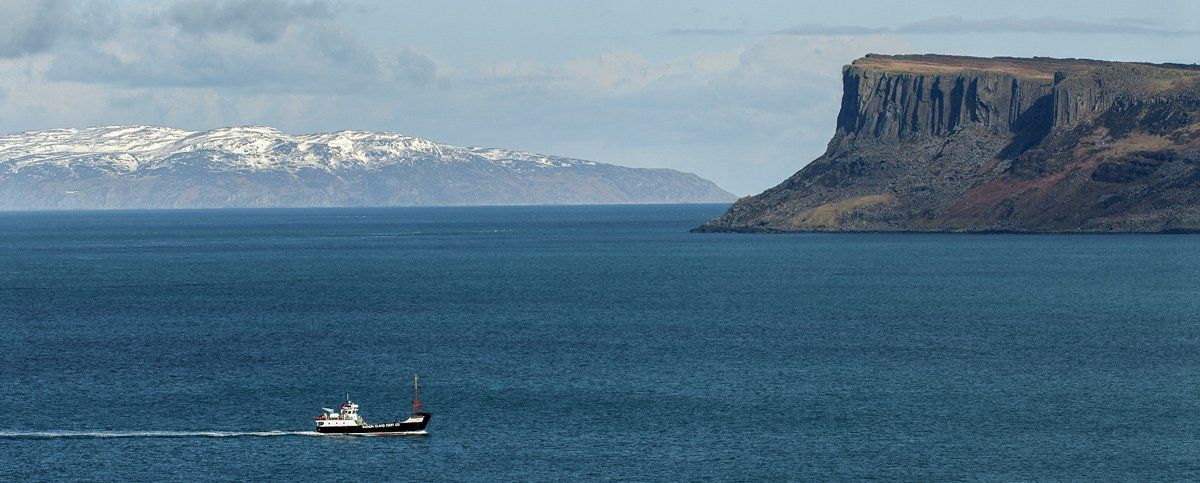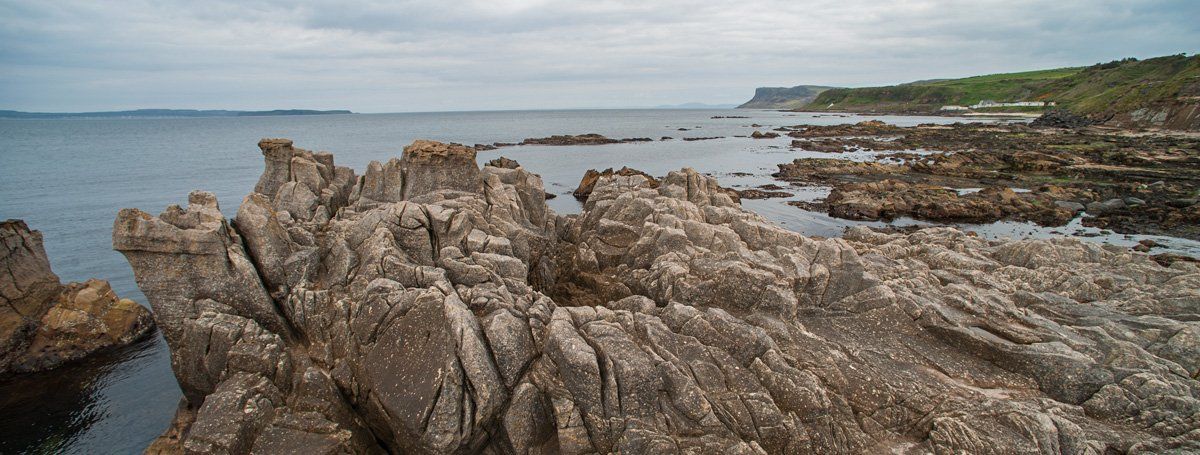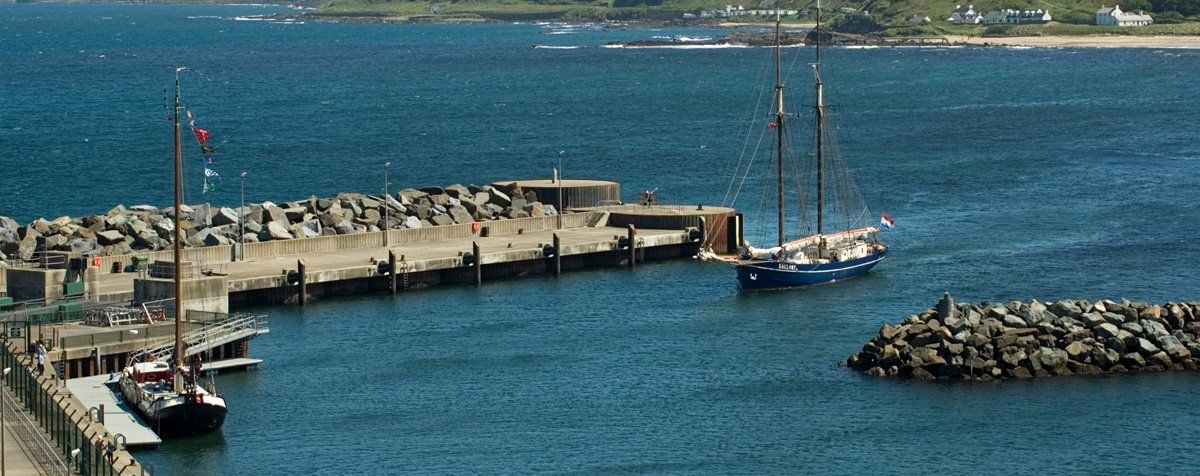Marconi was born in Bologna, Italy on April 25th 1874 to an Italian father and an Irish mother - his mother was Annie Jameson whose family owned the Jameson Whiskey Distillery. The work he instructed on Raghery and in Ballycastle covered a relatively short period from June 4th to September 2nd 1898, Marconi himself visited for four days during that time. The experimental work was carried out by his assistant George Kemp, who was assisted by Edward Glanville, also employed was John Cecil from Raghery. They carried out experimental transmissions between Kenmara House on the cliff above the harbour and east lighthouse on Raghery via a 104 foot aerial at the ‘White Lodge’ situated where the new ferry terminal is today - linking the town forever with the pioneering development of ‘wireless telegraphy’.
Heinrich Hertz who died in 1894, had discovered that electromagnetic waves existed in the air and that these could be detected over short distances, Sir William Crookes also predicted that these same electromagnetic waves could be used for communication. Marconi had studied physics and took inspiration from the work of Hertz, he carried out a series of practical experiments in wireless telegraphy in Italy and although Sir Oliver Lodge and Dr Alexander Muirhead claimed to have sent a ‘wireless’ signal between two Oxford buildings in 1894, it was Marconi who registered the first patent of this technology.
Many scientist were working in the same field but it was Marconi who realized the potential of the discovery which led him to register Patent No. 12039, on June 2nd 1896 -‘ with the specification for a ‘wireless’ system using Hertzian waves’. Some of his landmarks achievements are as follows:
1894 -
Italy – demonstrated the transmission of ‘wireless’ signals to sound a bell across a room.
1895 – Italy - demonstrated signal transmission and reception over a 2km distance across fields.
1896 - England - Registered his patent - demonstrated transmission and reception on Salisbury plain using an aerial developed by the Russian Prof. Alexander Popoff, Captain H. B. Jackson was present along with the chief engineer of the General Post Office and also representatives of the British Army.
1897
- England – He achieved a range of 7km transmission and reception on Salisbury Plain - achieved a new record distance of 14km when he sends a message across the Bristol Channel from Flat Holm, Weston-super-Mare to Lavernock Point, Cardiff – set up an aerial in the grounds of the Royal Needles Hotel, Alum Bay, Isle of Wight and communicated with two hired ferries and later with another station set up in the Medeira House, Bournemouth
1897 - Italy - communicated from La Spezia, Italy with the armoured cruiser ‘San Martino’ a distance of 11 miles - England - with his cousin Jameson Davis he first registered his company as The Wireless Telegraph and Signal Company.
1898
- Ireland
- transmission and reception between Raghery (Rathlin Island) and Ballycastle under commission by Lloyds of London – sent the world’s first live ‘wireless’ report of a yacht race from a ship called ‘The Flying Huntress’ to a shore station at Kingstown (Dublin). This brought immense publicity and interest for Marconi work and its commercial and military potential.
1899
- England
-The Goodwin Lightship which had been installed with a transmitter was rammed in heavy fog by the S.S. ‘R.F. Mathews’, it was able to send the first ‘live-saving’ signal from the sea, for the assistance of two lifeboats.
1901 –England - Send a signal 198 miles between the Isle of Wight and Lizard Point, Cornwall - defying critics and the opinions of the scientific world he sent a signal around the curvature of the earth, from Poldhu, Cornwall to Signal Hill, St John’s, Newfoundland. 1918: first signal from England to Australia. These are just a few of the scores of events and achievements during his lifetime and we have not touched on the greatest aid that his work created for shipping, namely the ability to sent 'wireless' distress signals which led to the saving of hundreds of thousands of lives at sea.
How or why Marconi came to Ballycastle to undertake the trails for Lloyds is not completely clear, it was certainly related to the fact that ‘wireless telegraphy’ promised to become the most important development in tracking incoming and outgoing vessels. The possibility had come of age when with Marconi equipped stations along the coast, vessels within twenty-five miles could make their presence known and send or receive communications. So apparent were the advantages of the system that Lloyds in May, 1898, entered into negotiations for the setting up of Marconi instruments at various Lloyds stations; and preliminary trial were commissioned between Rathlin Island and Ballycastle.
Another factor was that all transatlantic shipping to and from Liverpool passed between Torr Head and the Mull of Kintyre, Torr Head already had a signalling station - which relied on semaphore communication. These early contracts from Lloyds along with others from the Royal Navy, British Army and three shipping companies gave the new company its first income and the foundations of what today is a multinational corporation. There are some incorrect facts around the work that took place in Ballycastle - firstly the cottage referred to as ‘Marconi’s Cottage’ situated at the end of the road on the shoreline towards Fair Head, was not where transmissions were sent or received. As James O Kane, ex-Town Clerk of Moyle District Council pointed out in an article to the Irish News - the former Antrim County Council, misled by Post Office officials put a plaque on the cottage, not only was it at the wrong location but the date on the plaque was wrong.
Marconi’s assistant George Kemp arrived in Ballycastle on June 4th 1898 and was assisted by Edward Glanville, a young graduate of Trinity College, Dublin. Kemp also employed John Cecil from Raghery to assist in the work they would undertake and I am sure several other local people helped in the task of erecting and securing the mast at the east lighthouse and Ballycastle. Kemp identified the east lighthouse on Raghery and the harbour area in Ballycastle to be the best locations for the two signal stations. They set about erecting an eighty-foot aerial at the east lighthouse on Raghery, at first they could not get any reception at the harbour in Ballycastle and after researching other locations in Ballycastle they eventually increased the mast size at ‘White Lodge’, near the coal yards (where the present Ferry terminal car park is situated) to 104 feet.
This seems to solve the problem and on July 6th Kemp recorded the first signals transmitted from Raghery by Edward Glanville - they continued trails until George Kemp was instructed to go to Kingston (now Dun Laoghaire), Dublin. Marconi had been commissioned by the Dublin Daily Express to report the progress of the Kingston Regatta (July 20–22nd July 1898). He did this from a steam tug, sending 'wireless' messages back to the harbour where they were subsequently telephoned to Dublin. Becoming the world's first ‘live’ transmission of a sporting event, in the process he gained immense publicity for the technology and his Company. There seems to be some confusion as to some dates and whether Edward Glanville accompanied Kemp to Dublin or not. The Regatta was held on July 20-22nd 1898 which meant that Kemp and Granville would have been away together.
The untimely and tragic death of Edward Granville taking place on Sunday 21st July 1894 when he stumbled and fell down a cliff on Raghery would indicate he stayed on Raghery while Kemp went to Dun Laoghaire. Marconi is recorded as having arrived in Ballycastle on August 29th and spent four days here, during which time he visited and check the equipment and transmissions on Raghery, experienced the Lammas Fair on the 31st August and left for London on the 2nd of September. Marconi went on to develop short wave radio, the basis for most long-distance communications before satellite. He was also awarded a Nobel Prize for Physics in 1909 and on his death in 1937 was given a state funeral in his hometown of Bologne.











